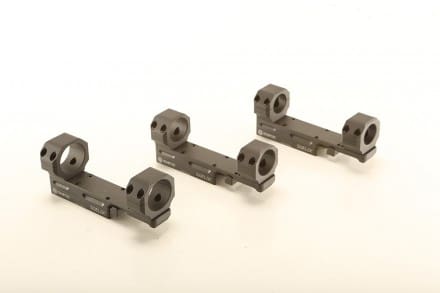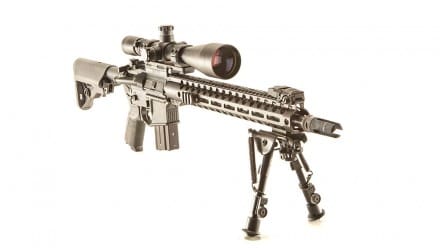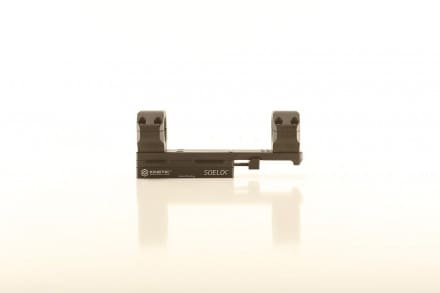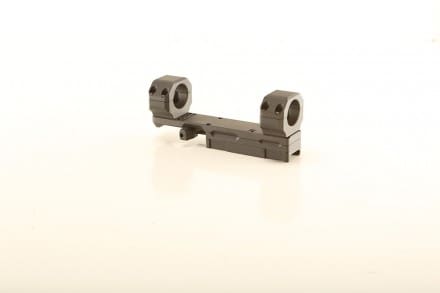The new KDG Modular Optic Mount is based off the proven Sidelok family of quick detach optic mounts, and features the same user-friendly, toolless design. KDG set out to design a Sidelok mount for all common, tube-style optics that will offer more user-configurable options than what is currently available from competing QD mounts. The Modular Optic Mount currently comes in three configurations, with ring sizes for 1”, 30mm and 34mm tubes.
The lightweight aluminum mount uses KDG’s Sidelok (pat. pending) cam lock system to attach to all picatinny rails instantly. With zero tools needed to attach the mount, the user simply rocks their optic onto the chosen mounting space, and down onto the rail. Once pressed down, the Modular Optic Mount self-locks, and the optic can be zeroed in the usual fashion. Removal is equally fast, and can be accomplished with one hand even while wearing gloves. The front located release button has a smaller, recessed secondary lock, which must be deliberately pressed in and to the rear to facilitate removal. The Sidelok system makes it virtually impossible to accidentally engage the release, and its cam lock system ensures a secure grasp on various sized (and some out of spec) picatinny rails. This equates to a fast, easy means of removing and attaching optics while retaining an absolute return to zero.
The mount is offered with a user removable cantilever bar, in which the rings securely mount. This bar runs parallel to the weapon’s bore, and is ideal for all semi and fully automatic carbines, rifles and DM style firearms. KDG plans to release a separate 20 MOA bar in the future, for those that might require the added elevation for particular optic or application.
The matched front and rear rings are CNC machined, and wire EDM cut to be as precisely concentric as possible. The upper and lower ring remain matched for the duration of its production, and feature witness marks for assembly in the form of recessed dots. This allows the user to match the proper ring to its base, and ensure the mount is as truly aligned as possible. The rings themselves can be adjusted forward or back to the user’s preference, to avoid interference with large front objective bells, turret adjustment knobs, and rear magnification adjustment collars. The rings themselves bolt into a track system to facilitate this adjustment. The same track system allows the user to purchase and install separate rings in the future, should they decide to change to an optic with a larger or smaller diameter tube. This feature will save the shooter or organization money, as the majority of cost is in the base of the unit.
The Modular Optic Mount is now available to order on Kinetic Development Group’s website, and from authorized dealers. The 1”, 30mm, and 34mm mounts come with all hardware and instructions needed for immediate assembly, and will fit nearly all popular magnified optics currently on the market. With an MSRP of $224.99, the Modular Optic Mount just might be the last mount you ever need to buy. For more information, please check out kineticdg.com.







What does this do that the Picatinny rail mounts don’t do?
It is a Picatinny rail mount.
That made me chortle
So, I’m putting an interchangeable optics mount on another interchangeable mount system. Makes sense. (Cue Xzibit)
Yo dawg, I heard you like interchangeable mounts, so I put an interchangeable mount on your interchangeable mount!
I don’t think you are understanding this, like at all, in anyway.
This made ME chortle.
Perform a search for Kinetic Development Group on this website. You will find other posts detailing the function of the Sidelok family of products.
(not affiliated with KDG, I just pay attention)
oooh. How insightful. You’re just the clever one, asking me to do a search.
That presupposes I care enough to research this further, which is a big assumption to make. I’m just asking the obvious (rhetorical) question here, but apparently that was bit over your head. Apologies.
Wow. Reddit.com/r/Iamverysmart
Her gig line is off.
That was the LAST thing I would have noticed since I traded in my NCO eyes, but now I can’t see anything else in that picture.
To answer your question and a few points that are not in the article, you can’t put this on wrong. It is completely mechanical. Both sideloks are deployed automatically as you roll it on the rifle at the exact same time and same pressure. The mechanical advantage from the cams gives over 200 pounds of locking force to move them (that does not mean there is 200 pounds applied to the rail, it only means it would take 200 pounds of prying power to open the side locks. Pushing the recessed button, and the whole button only requires a few pounds to unlock.
So if both side locks are fired at the exact same time with the exact same pressure on the picatinny rail, and you re-install the recoil lug on the bottom to the same exact slot, you will have 100% zero. Professional snipers install their mounts with torque wrenches and alternate tightening each bolt one turn so the mount does not cant one direction or the other in an attempt to get as close a return to zero as possible.
For the first time you really can configure your rifle for a cqb optic then back without the worry that you will lose zero. As these ship, people will test this, and write reveiws on what we already know, because we invented and perfected it for this purpose.
There are no protrusions of levers on either side. It is completely slick sided. Nothing to interfere with a side charger, or hang up on gear.
The worst thing about adjustable levers is they can be too tight, too loose, or worse yet, one is tighter than the other creating a remounting variable that will get you close to your original zero. What if you installed your lever mount the first time tightening the front first, the rear second? Both have different adjustment. Then you remount the next time tightening the levers in opposite order? I moves the scope in one direction or the other.
Because this is 100% mechanical and automatic, you can remove a ton of variables which is why it returns to zero so perfectly.
Also if you use a heavier scope, the side locking bars tighten on the first shot from the recoil and stay at the optimal clamping force.
This was recently issued a US patent. It has been adopted in large numbers by a federal agency in the aimpoint micro version for the reasons I outline above. The Army is interested because the only mistake you can make installing the optic is putting the optic on backward. There are no external nuts or bolts or adjustment screws to lose or improperly manipulate.
You asked, I answered. It has a massive amount of merit and is cost comparable to the other products on the market.
“So if both side locks are fired at the exact same time with the exact same pressure on the picatinny rail, and you re-install the recoil lug on the bottom to the same exact slot, you will have 100% zero.”
Sorry I meant to say “return to zero.”
For a product release, you might want to go with pictures that show the product in detail. Pictures of a girl are nice, but don’t impress me in the least. An image showing the underside would have been helpful, as there is nothing showing what makes this a better mount. The pictures that are present don’t show detail, and everything looks orange.
Sorry, I’m a visual person, as are most others who come here. A large picture with small object is a waste of time.
As for the return to zero, get a set over to RECOIL. They are the only magazine I’ve seen do a legit test on mounts. For disclosure, I do write for RECOIL, but I’m not asking to write an article. It should go to the same guys who wrote the last series so it is consistent. Between mounts that damage optics and receivers, to mounts that fall off, I’ve seen just about everything. If you have a better mouse trap, you guys need to get the word out and prove it.
Best of luck, as the optic mount market can certainly be improved on.